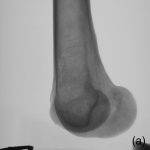Humanities
Osteoarchaeology
Computed Tomography Scanning vs Handheld Laser Scanning of Archaeological Artefacts
Background
This report studied the potential for handheld laser scanning technology to supplant CT scanning in the generation of 3D digital models of archaeological artefacts. The 3D models of archaeological artefacts are valuable in a number of ways; from artefact preservation, to increasing outreach, to enabling analytical computational research.
Role of Computed Tomography
The computed tomography scanner available at µ-VIS was used to fully scan a preserved femur dated to the 2nd – 3rdcenturies. This artefact was scanned with both CT and handheld laser scanners to allow for an accurate comparison between the two imaging methods. The data acquired by the micro-CT was reconstructed into a 3D model of the femur. This model was used to generate a final high-resolution surface mesh which was quantitively and qualitatively compared to the meshes outputted by the handheld scanners.
Acknowledgements
This project would have not been successful without the support of a number of individuals, namely Professor Martin Browne, Dr Alex Dickinson, Dr Orestis L Katsamenis, and Dr Sonia Zakrzewski.
Raimundo Garcia-Figueras Mateos












